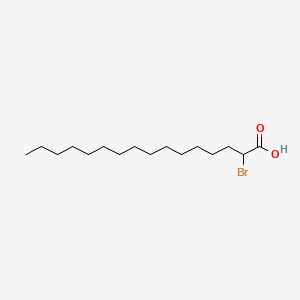| MeSH term | MeSH ID | Detail |
|---|---|---|
| Hyperinsulinism | D006946 | 27 associated lipids |
| Cardiomegaly | D006332 | 31 associated lipids |
| Diabetes Mellitus | D003920 | 90 associated lipids |
| Carcinoma, Hepatocellular | D006528 | 140 associated lipids |
| Body Weight | D001835 | 333 associated lipids |
2-bromohexadecanoic acid
2-bromohexadecanoic acid is a lipid of Fatty Acyls (FA) class. 2-bromohexadecanoic acid is associated with abnormalities such as Varicosity and Coronavirus Infections. The involved functions are known as Cell Proliferation, Apoptosis, Binding (Molecular Function), Regulation and Biochemical Pathway. 2-bromohexadecanoic acid often locates in Membrane, Cytoplasm, Mitochondria, Cell surface and Extracellular. The associated genes with 2-bromohexadecanoic acid are SLC33A1 gene, GRK6 gene, RBP1 gene, DST gene and FATE1 gene. The related lipids are Palmitates, Fatty Acids, Nonesterified Fatty Acids, Fatty Acids, Unsaturated and Oleates.
Cross Reference
Introduction
To understand associated biological information of 2-bromohexadecanoic acid, we collected biological information of abnormalities, associated pathways, cellular/molecular locations, biological functions, related genes/proteins, lipids and common seen animal/experimental models with organized paragraphs from literatures.
What diseases are associated with 2-bromohexadecanoic acid?
2-bromohexadecanoic acid is suspected in Varicosity, Coronavirus Infections and other diseases in descending order of the highest number of associated sentences.
Related references are mostly published in these journals:
| Disease | Cross reference | Weighted score | Related literature |
|---|
Possible diseases from mapped MeSH terms on references
We collected disease MeSH terms mapped to the references associated with 2-bromohexadecanoic acid
PubChem Associated disorders and diseases
What pathways are associated with 2-bromohexadecanoic acid
There are no associated biomedical information in the current reference collection.
PubChem Biomolecular Interactions and Pathways
Link to PubChem Biomolecular Interactions and PathwaysWhat cellular locations are associated with 2-bromohexadecanoic acid?
Visualization in cellular structure
Associated locations are in red color. Not associated locations are in black.
Related references are published most in these journals:
| Location | Cross reference | Weighted score | Related literatures |
|---|
What functions are associated with 2-bromohexadecanoic acid?
Related references are published most in these journals:
| Function | Cross reference | Weighted score | Related literatures |
|---|
What lipids are associated with 2-bromohexadecanoic acid?
Related references are published most in these journals:
| Lipid concept | Cross reference | Weighted score | Related literatures |
|---|
What genes are associated with 2-bromohexadecanoic acid?
Related references are published most in these journals:
| Gene | Cross reference | Weighted score | Related literatures |
|---|
What common seen animal models are associated with 2-bromohexadecanoic acid?
There are no associated biomedical information in the current reference collection.
NCBI Entrez Crosslinks
All references with 2-bromohexadecanoic acid
Download all related citations| Authors | Title | Published | Journal | PubMed Link |
|---|---|---|---|---|
| Huang R et al. | Chemical genomics profiling of environmental chemical modulation of human nuclear receptors. | 2011 | Environ. Health Perspect. | pmid:21543282 |
| Levy AD et al. | Subcellular Golgi localization of stathmin family proteins is promoted by a specific set of DHHC palmitoyl transferases. | 2011 | Mol. Biol. Cell | pmid:21471001 |
| Ho GP et al. | S-nitrosylation and S-palmitoylation reciprocally regulate synaptic targeting of PSD-95. | 2011 | Neuron | pmid:21745643 |
| Szkudelski T and Szkudelska K | Short-term effects of palmitate and 2-bromopalmitate on the lipolytic activity of rat adipocytes. | 2011 | Life Sci. | pmid:21819998 |
| Heakal Y et al. | Neurotensin receptor-1 inducible palmitoylation is required for efficient receptor-mediated mitogenic-signaling within structured membrane microdomains. | 2011 | Cancer Biol. Ther. | pmid:21725197 |
| Bunn RC et al. | Palmitate and insulin synergistically induce IL-6 expression in human monocytes. | 2010 | Cardiovasc Diabetol | pmid:21054880 |
| Maharjan S et al. | Membrane-initiated estradiol signaling increases tyrosine hydroxylase promoter activity with ER alpha in PC12 cells. | 2010 | J. Neurochem. | pmid:19818101 |
| Guardiola-Serrano F et al. | Palmitoylation of human FasL modulates its cell death-inducing function. | 2010 | Cell Death Dis | pmid:21368861 |
| Tomatis VM et al. | Acyl-protein thioesterase 2 catalyzes the deacylation of peripheral membrane-associated GAP-43. | 2010 | PLoS ONE | pmid:21152083 |
| Paskaleva EE et al. | Palmitic acid analogs exhibit nanomolar binding affinity for the HIV-1 CD4 receptor and nanomolar inhibition of gp120-to-CD4 fusion. | 2010 | PLoS ONE | pmid:20730055 |
